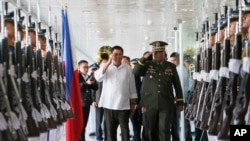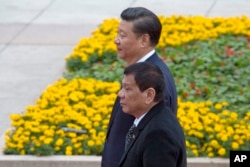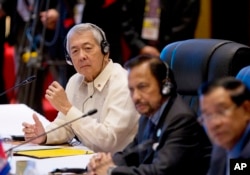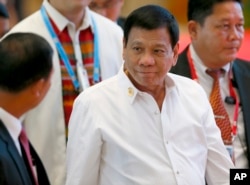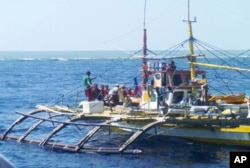Philippine President Rogrigo Duterte’s shifts in policy on China and United States is adding a fresh layer of uncertainty to the Association of South East Asian Nations (ASEAN).
The 10-nation group, set to mark its 50th Anniversary next year with the Philippines occupying the chair, is already beset by divisions focused on China’s rising influence and the United States’ strategic role in the region.
During a recent official visit to Beijing, Duterte announced the “separation” with long time strategic partner the U.S. in favor of China, only to retreat from the position upon his return to the Philippines.
“I said separation – what I was really saying was separation of a foreign policy. In the past and until I became President we always follow what the United States would give. Separation of my foreign policy – that it need not dovetail the foreign policy of America – that’s what I meant. Sever is to cut – separate is just another way of doing it,” Duterte said.
Philippines reassures US
Philippine Foreign secretary, Perfecto Yasay moved to reassure the international community by telling visiting U.S. Assistant secretary of State for East Asian and Pacific Affairs, Daniel Russel, that Duterte had “already walked back” his comments.
But analysts say uncertainties over Dutere’s policy shifts will have a wider impact within ASEAN.
Carl Thayer, a defense analyst with the University of New South Wales in Australia, said Duterte’s unilateral comments may affect ASEAN regional stability as the President fails to prior consult other ASEAN members.
“The uncertainty in the region by unilateral actions is something that Duterte’s going to need to address because shortly the Philippines becomes the chair of ASEAN starting next year,” Thayer said.
South China Sea tensions
But Thayer said a positive outcome to Duterte’s visit to China is the likely easing of regional tensions over conflicts over the South China Sea. Former Philippine President, Benigno Aquino unilaterally challenged China’s maritime claims in the South China Sea. In July an arbitral tribunal ruled against China, a verdict rejected by Beijing.
“The South China Sea is no longer the issue that it was when the arbitration case was pending and the way Duterte is handling it. It has taken the sting out of that issue and provided China with the incentives to pick up [Duterte’s] diplomatic initiative,” he said.
Long term impact
He said a less assertive China in the region is to be welcomed by other ASEAN members.
But Thitinan Pongsudhirak, director of the Bangkok-based Institute of Security and International Studies (ISIS), said Duterte’s uncertain policy shifts may impact ASEAN over the longer term.
“This is going to spell long term implications for ASEAN because Manila/Philippines is a long term treaty ally of the United States and Thailand is the other ally. So two allies of America in South East Asia are relatively estranged now. This is going to be a dramatic tipping point for China-U.S. relations in the region,” he said.
Thitinan added that another risk is the future of President Obama’s pivot to Asia policy, leaving the U.S. to adjust its regional policies.
China's growing influence
He says recent events further highlight Beijing’s growing influence over Southeast Asia’s mainland nations -- Cambodia, Laos, Myanmar and Thailand.
“This means that ASEAN is going to be in Beijing’s orbit next year much more than Washington and Washington will have to really think about what to do in the long term. This is detrimental for ASEAN because ASEAN wants a balance between Washington and Beijing – not to be too much one way or the other,” he said.
Diplomatic efforts within ASEAN to set a unified policy over China and the South China Sea have been seen to be undermined as Beijing countered with diplomacy to isolate individual countries.
Ashley Townsend, a research fellow at Australia’s Sydney University, sees increasing difficulties for ASEAN in finding a common position over issues such as island reclamation and militarization of the South China Sea.
“Duterte’s comments and not just his rhetoric, but his very uncertain movement between the United States and China – or apparent movement – makes it very difficult for other ASEAN countries that are used to a much more stable direction in their region’s foreign policies to really gauge where the Philippines under Duterte is likely to go,” Townsend said.
ASEAN stability shaken
But he warns a “divided foreign policy” in the Philippines will leave ASEAN as an organization “in limbo when it comes to these big regional strategic questions about policy towards the South China Sea or ASEAN’s place, vis-a-vis the U.S. and China.”
Others, such as Dennis Quilala, an associate professor at the University of the Philippines, remain cautious but see Duterte’s China policy as being in the “best interests of the Philippines” by easing regional tensions.
But Quilala still holds concerns over the possible impact of the president’s policy shift.
“I am really afraid if it’s just a shift of who our new masters will be. That’s what I’m afraid of. I hope that the policies really are able to successfully work with both superpowers and be able to think about our interests. I hope that this will end that way because I really don’t think that our interests is just going all the way to China,” Quilala said.
He said to understand the Philippines’ foreign policy under President Duterte it is best to wait for the policy pronouncements “coming out from the bureaucracy – that is the safest way to understand [Duterte] I guess.”




